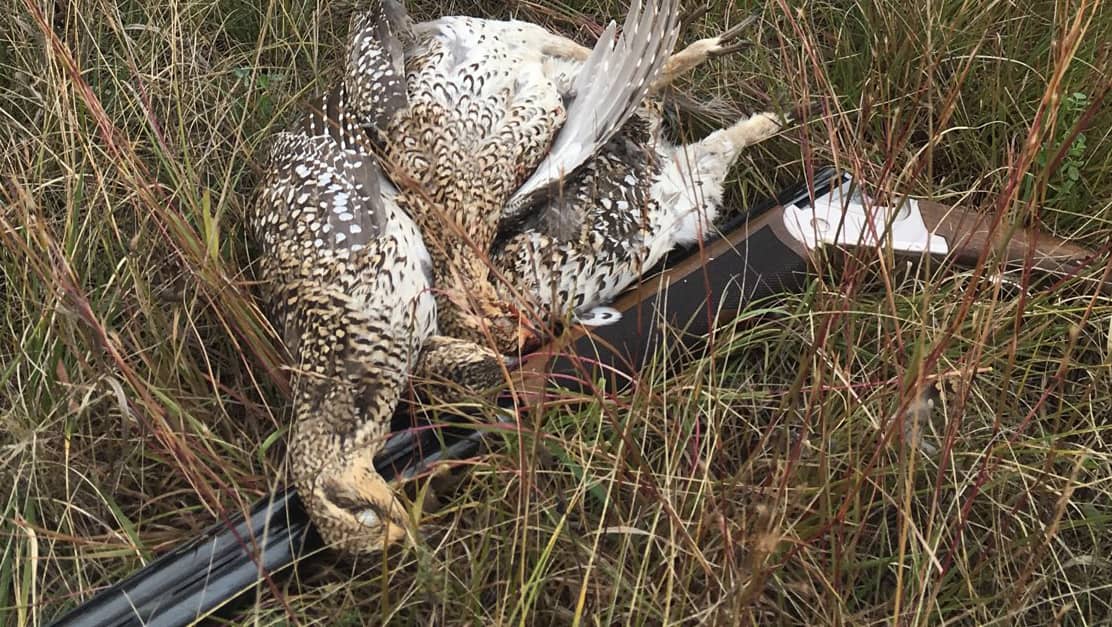
Hunters may find more success and more young-of-the-year sharptailed grouse on the landscape this fall, as later hatches and better conditions likely produced more birds than the dry conditions of 2021. Simonson Photo.
By Nick Simonson
With the completion of the roadside brood surveys for North Dakota’s upland game, and the sharptailed grouse and Hungarian partridge season opener set for this Saturday, hunters may find a better crop of younger grouse in comparison to 2021 and might likely encounter more Hungarian partridge in their walks this fall. North Dakota Game & Fish Department (NDG&F) Upland Game Management Supervisor Jesse Kolar suggests that while early nesting efforts by grouse may have been hampered by weather, both species likely produced more offspring later in the summer, under the vegetation and grass cover spurred by damp conditions in spring.
“A good note for sharptails; their reproduction seemed like it was a lot better [compared to 2021]. Conditions rebounded this summer, so the later period of their nesting seemed like it did a little better and they were able to kick out some chicks,” Kolar relays, adding that partridge, while uncommon, are stable to improved across the state, “Partridge remain as high as they have been in 15 years. They look really good. I think populations will be good from Jamestown and further west,” he concludes.
Keep a Sharp Eye
Impacts of last summer’s drought linger in the populations of sharptailed grouse in North Dakota, as the number of adult birds was lower due to lack of recruitment in 2021 which resulted from chick die-offs in the dry conditions from limited food and insects which comprise their early diets. This spring’s lekking counts, where NDG&F agents observe mature sharptailed grouse on their mating grounds, confirmed that fact as the birds’ tallies were off notably. Hunters will likely find more young-of-the-year grouse on the prairie after better conditions this summer – albeit later developing in the nesting season – helped bring this year’s grouse chicks along.
“We forecasted things would be down this spring, and everybody knew that after the drought last year was pretty severe. That is what we thought with sharptails, the adults started lower, so our total grouse per mile in our reproductive surveys reflected that they were lower. Then the nesting, we would expect that looking at the ground now everybody thought we were just going to have a boom crop of birds, but it came a little late. Our early nesting was probably clipped off; it was the April blizzards and then really wet, cool weather that we had in the first part of May probably affected them,” Kolar explains.
Huns Bouncing off Bottom?
Hungarian partridge, also known as gray partridge, are holding stable and even improving in some areas of the state, as conditions aligned for a small rebound. Accustomed to more arid conditions, and able to forage in those areas of lesser cover, partridge showed up a bit more in this summer’s roadside surveys, and their abundance expanded to the east as well.
“This year for the first time the prairie pothole region – that second district from the west – caught up with the southwest and had just as high of numbers as the southwest. The entire one-third of the western part of North Dakota has as high of numbers as we’ve had for 15 years for partridge. Then even further east, the numbers seemed like they were pretty good, and they’ve been climbing for five or six years in a row now,” Kolar states regarding the results of the 2022 summer roadside tally for Hungarian partridge in the state.
While in the late 1980s and early 1990s North Dakota’s survey results were up to 35 partridge for every 100 miles driven, they dropped off suddenly in the early 1990s. Right now, overall, the state is at a level of about 12 for every 100 miles, so about a third of what they were three decades ago, but even that current number is considered good based on the recent history of the small upland birds.
“We do know that dry conditions, fallow fields which have gone away and some of those combinations of things and certain alignment of the stars that happened in the late 1980s I think really benefitted partridge,” Kolar posits for the drop in partridge over the last three decades, adding, “Certainly those CRP plantings can be good for pheasants for years three to six, but I think that for partridge they are really good in year one to five. So, when the CRP planting just goes in and it looks a little weedy and rough around the edges, that’s what those partridge really liked.”
For the approaching opener, Kolar recommends the best thing for hunters to focus on when pursuing partridge and grouse is to think where water currently is, and where it was several weeks ago.
“As we get drier this fall, think not just where water and riparian areas are now, but imagine where those riparian areas and moist areas were in August, and that’s where most of the hens were taking their chicks to find insects, so look for those areas and they should be somewhere near there,” he concludes.
The North Dakota Sharptailed Grouse, Hungarian Partridge, Ruffed Grouse and Tree Squirrel hunting seasons open on Saturday, September 10. Hunting hours are a half hour before sunrise until sunset.
